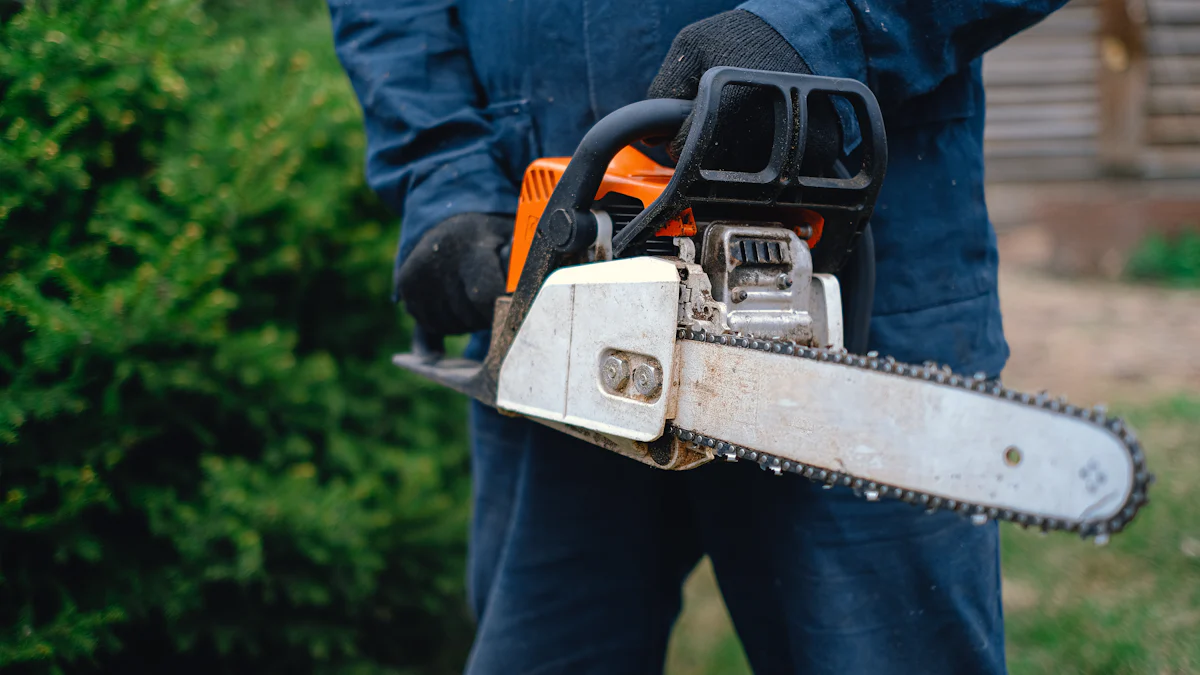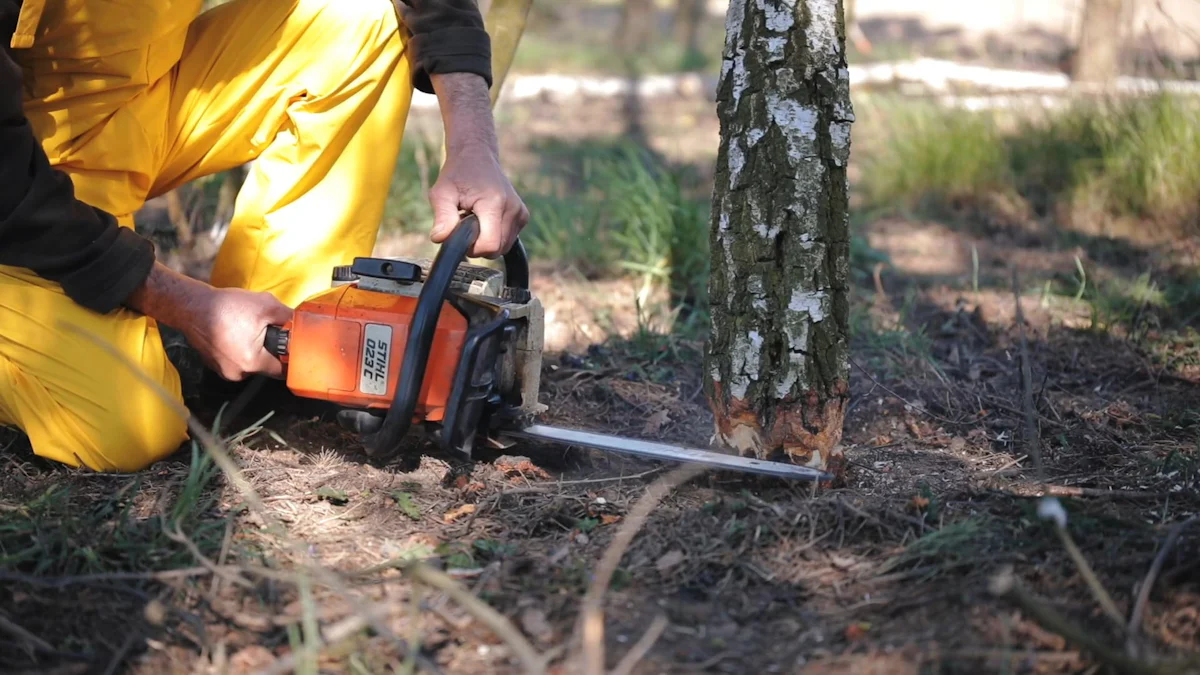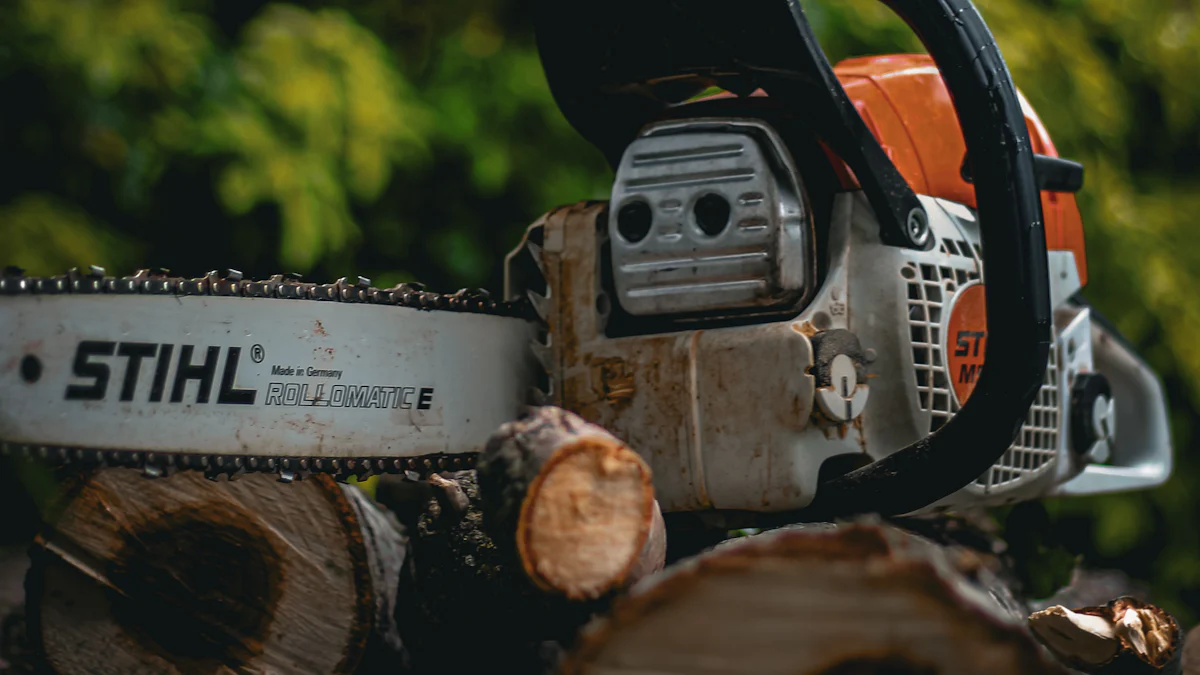
Having the right tree cutting tools is essential for every homeowner. Proper tools ensure efficient and safe tree maintenance. Well-maintained trees enhance the beauty of a property and promote healthy growth. Safety considerations are crucial. Inadequate or improper safety procedures can lead to severe injuries or fatalities. According to NIOSH, many tree trimmers lack training and knowledge of OSHA standards. Wearing appropriate personal protective equipment and following safety protocols can prevent accidents.
Essential Tree Cutting Tools

Chainsaw
Types of Chainsaws (Gas, Electric, Battery)
Chainsaws are indispensable tree cutting tools for homeowners. Three main types exist: gas, electric, and battery-powered chainsaws. Gas chainsaws provide high power and mobility, making them suitable for heavy-duty tasks. Electric chainsaws offer quieter operation and require less maintenance. Battery-powered chainsaws combine the benefits of electric chainsaws with the freedom of movement found in gas models.
Key Features to Look For
When selecting a chainsaw, consider several key features. Bar length determines the size of branches or trees the chainsaw can cut. Engine power or battery voltage affects cutting efficiency. Look for safety features like chain brakes and low kickback bars. Weight and ergonomics impact ease of use and fatigue levels during operation.
Safety Tips for Using Chainsaws
Safety is paramount when using chainsaws. Always wear protective gear, including gloves, goggles, and helmets. Inspect the chainsaw before each use to ensure it functions correctly. Maintain a firm grip and stable stance while operating the chainsaw. Keep bystanders at a safe distance. Follow the manufacturer’s guidelines for proper use and maintenance.
Pruning Shears
Types of Pruning Shears (Bypass, Anvil)
Pruning shears are essential for precise cuts on smaller branches and twigs. Two main types exist: bypass and anvil pruning shears. Bypass pruning shears have two curved blades that slide past each other, providing clean cuts. Anvil pruning shears feature a straight blade that cuts against a flat surface, suitable for cutting dead wood.
Best Uses for Pruning Shears
Bypass pruning shears excel at cutting live branches and stems without damaging plant tissues. Use anvil pruning shears for trimming dead or dry branches. Pruning shears are ideal for shaping shrubs, removing suckers, and maintaining small trees.
Maintenance Tips
Proper maintenance extends the lifespan of pruning shears. Clean the blades after each use to remove sap and debris. Sharpen the blades regularly to ensure clean cuts. Lubricate the pivot point to maintain smooth operation. Store pruning shears in a dry place to prevent rust.
Loppers
Types of Loppers (Bypass, Anvil)
Loppers are powerful tree cutting tools designed for thicker branches. Two main types exist: bypass and anvil loppers. Bypass loppers have two blades that pass by each other, providing clean cuts. Anvil loppers feature a single blade that cuts against a flat surface, suitable for cutting dead wood.
Ideal Uses for Loppers
Bypass loppers are perfect for cutting live branches up to 2 inches in diameter. Use anvil loppers for trimming dead or dry branches. Loppers are ideal for pruning fruit trees, shaping hedges, and maintaining medium-sized trees.
How to Maintain Loppers
Maintenance ensures optimal performance of loppers. Clean the blades after each use to remove sap and debris. Sharpen the blades regularly to maintain cutting efficiency. Lubricate the pivot point for smooth operation. Store loppers in a dry place to prevent rust.
Trimming and Shaping Tools

Pole Saw
Types of Pole Saws (Manual, Powered)
Pole saws help homeowners reach high branches without using a ladder. Two main types exist: manual and powered pole saws. Manual pole saws require physical effort to cut branches. Powered pole saws include electric, battery, and gas options. Electric pole saws offer quiet operation. Battery-powered pole saws provide mobility without cords. Gas pole saws deliver high power for heavy-duty tasks.
Best Practices for Using Pole Saws
Using a pole saw correctly ensures efficient tree trimming. Always inspect the pole saw before use. Check for any damage or loose parts. Hold the pole saw firmly with both hands. Position the saw blade on the branch to be cut. Apply steady pressure while cutting. Avoid overreaching to maintain balance. Trim branches in small sections to prevent accidents.
Safety Considerations
Safety remains crucial when using pole saws. Wear protective gear, including gloves, goggles, and helmets. Keep bystanders at a safe distance. Follow the manufacturer’s guidelines for proper use. Maintain a stable stance while operating the pole saw. Inspect the area for electrical wires and other hazards. NIOSH recommends developing comprehensive safety programs for tree care operations.
Hedge Trimmers
Types of Hedge Trimmers (Gas, Electric, Battery)
Hedge trimmers help shape and maintain hedges and shrubs. Three main types exist: gas, electric, and battery-powered hedge trimmers. Gas hedge trimmers provide high power and are suitable for large areas. Electric hedge trimmers offer quieter operation and require less maintenance. Battery-powered hedge trimmers combine the benefits of electric models with the freedom of movement found in gas models.
Key Features to Look For
Selecting the right hedge trimmer involves considering several features. Blade length affects the size of hedges that can be trimmed. Weight and ergonomics impact ease of use and fatigue levels. Look for safety features like blade guards and dual-switch controls. Battery life is important for battery-powered models. Engine power determines cutting efficiency for gas models.
Maintenance and Safety Tips
Proper maintenance extends the lifespan of hedge trimmers. Clean the blades after each use to remove sap and debris. Sharpen the blades regularly to ensure clean cuts. Lubricate moving parts to maintain smooth operation. Store hedge trimmers in a dry place to prevent rust. Safety remains paramount. Always wear protective gear, including gloves and goggles. Follow the manufacturer’s guidelines for proper use and maintenance.
Specialty Tree Cutting Tools
Tree Pruning Saws
Types of Pruning Saws (Folding, Fixed Blade)
Tree pruning saws are essential for cutting thicker branches. Two main types exist: folding and fixed blade pruning saws. Folding pruning saws offer portability and safety. The blade folds into the handle, making storage easy. Fixed blade pruning saws provide durability and strength. These saws are ideal for heavy-duty tasks.
Best Uses for Pruning Saws
Pruning saws excel at cutting through larger branches and stems. Use folding saws for quick, on-the-go tasks. Fixed blade saws like the Felco #611 and Fanno 30″ Pruning Saw No. RF-05 are perfect for larger wood. Pruning saws are suitable for shaping trees and removing dead or diseased branches.
Maintenance Tips
Proper maintenance ensures the longevity of pruning saws. Clean the blades after each use to remove sap and debris. Sharpen the blades regularly to maintain cutting efficiency. Store pruning saws in a dry place to prevent rust. Avoid using pruning saws in the dirt to keep them sharp.
Hatchet
Types of Hatchets
Hatchets are versatile tree cutting tools. Different types include camping hatchets, splitting hatchets, and carpenter’s hatchets. Camping hatchets are lightweight and portable, designed for outdoor activities. Splitting hatchets have a heavier head, ideal for splitting wood. Carpenter’s hatchets feature a flat edge for precision work.
Ideal Uses for Hatchets
Hatchets are perfect for chopping small branches and splitting wood. Use a hatchet for clearing brush and preparing firewood. The Milwaukee M18 Hatchet is designed for professional arborists and landscapers. This hatchet offers fast cutting with an 8-inch blade, suitable for demanding pruning applications.
Safety Tips
Safety remains crucial when using hatchets. Always wear protective gear, including gloves and goggles. Maintain a firm grip and stable stance while using the hatchet. Inspect the hatchet before each use to ensure it functions correctly. Keep bystanders at a safe distance.
Wood Chipper
Types of Wood Chippers (Electric, Gas)
Wood chippers are powerful tree cutting tools for processing branches and debris. Two main types exist: electric and gas wood chippers. Electric wood chippers offer quieter operation and require less maintenance. Gas wood chippers provide high power and mobility, suitable for heavy-duty tasks.
Key Features to Look For
Selecting the right wood chipper involves considering several key features. Engine power determines the chipper’s efficiency. Chipping capacity indicates the maximum branch diameter the chipper can handle. Look for safety features like automatic shutoff and feed control. Portability is important for moving the chipper around the property.
Safety and Maintenance Tips
Proper maintenance extends the lifespan of wood chippers. Clean the chipper after each use to remove debris. Sharpen the blades regularly to ensure efficient chipping. Lubricate moving parts to maintain smooth operation. Store wood chippers in a dry place to prevent rust. Safety remains paramount. Always wear protective gear, including gloves and goggles. Follow the manufacturer’s guidelines for proper use and maintenance.
Additional Considerations
Safety Gear
Essential Safety Gear (Gloves, Goggles, Helmets)
Proper safety gear is essential for anyone using tree cutting tools. The most important items include gloves, goggles, and helmets. Gloves protect hands from sharp branches and rough surfaces. Goggles shield eyes from flying debris and sawdust. Helmets guard against falling branches and other head injuries.
Importance of Using Safety Gear
Using safety gear can prevent serious injuries. Robert Savage shared his experience where wearing helmets and belts saved his family from major trauma during an accident. This highlights the importance of protective equipment. Ethan from Thompson Safety emphasized that having the right personal protective equipment (PPE) ensures safety and compliance. Safety gear not only protects but also boosts confidence while working with tree cutting tools.
Tool Maintenance
General Maintenance Tips
Maintaining tree cutting tools extends their lifespan and ensures efficient operation. Clean tools after each use to remove sap and debris. Sharpen blades regularly to maintain cutting efficiency. Lubricate moving parts to ensure smooth operation. Store tools in a dry place to prevent rust.
Importance of Regular Maintenance
Regular maintenance of tree cutting tools is crucial. Well-maintained tools perform better and last longer. Proper maintenance reduces the risk of accidents caused by faulty equipment. A well-maintained toolset ensures homeowners can tackle any tree cutting task safely and efficiently.
Having the right tree cutting tools is crucial for efficient and safe tree maintenance. Investing in quality tools ensures long-term benefits and reduces the need for frequent replacements. Proper tools enhance the beauty and health of trees, contributing to a well-maintained property.
“I highly recommend this saw for anyone with branches that cannot be reached without hiring a tree company… which would cost a lot more.” – Amazon Customer
Safety remains paramount. Always wear appropriate protective gear and follow safety protocols. Regular maintenance of tools extends their lifespan and ensures optimal performance.
